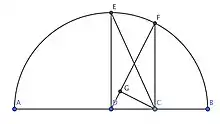HM-GM-AM-QM inequalities
In mathematics, the HM-GM-AM-QM inequalities state the relationship between the harmonic mean, geometric mean, arithmetic mean, and quadratic mean (aka root mean square, RMS). Suppose that are positive real numbers. Then
These inequalities often appear in mathematical competitions and have applications in many fields of science.
Proof
There are various methods to prove the inequalities, including mathematical induction, the Cauchy–Schwarz inequality, Lagrange multipliers, and Jensen's inequality. The links to some methods of proof are included below.
The n = 2 case

When n = 2, the inequalities become for all which can be visualized in a semi-circle whose diameter is [AB] and center D.
Suppose AC = x1 and BC = x2. Construct perpendiculars to [AB] at D and C respectively. Join [CE] and [DF] and further construct a perpendicular [CG] to [DF] at G. Then the length of GF can be calculated to be the harmonic mean, CF to be the geometric mean, DE to be the arithmetic mean, and CE to be the quadratic mean. The inequalities then follow easily by the Pythagorean theorem.
